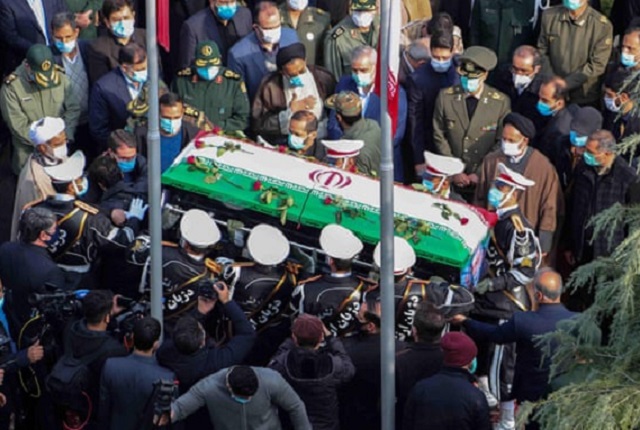
New details are emerging about an attack that killed Iran’s most senior nuclear scientist last Friday. Initially, it was thought that Mohsen Fakhrizadeh’s car was attacked by undentified gunmen armed with automatic weapons and explosives. However, a Fars news agency report on Sunday evening states that Fakhrizadeh was actually killed by a remote-controlled weapon mounted in a vehicle that subsequently exploded. Iran has blamed Israel and an opposition group in exile called Mujahedeen-e-Khalq for the attack. A senior Iranian security official has described it as “highly complex”, adding that it was carried out with “electronic devices”.
While Mohsen Fakhrizadeh is the most senior nuclear scientist to be killed in mysterious circumstances in Iran, he is by no means the first with Tehran holding Israel accountable for at least five assassinations. The first high-profile killing happened in early 2010 when Masoud Ali Mohammadi died after a bomb was detonated on a motorcycle when he left his home. The pattern of targeting nuclear scientists during their commute repeated itself in subsequent incidents and Majid Shahriar died when a motorcyclist attached a bomb to his car in November 2010. It remains unclear whether Darioush Rezaeineja was connected to the nuclear program but he was shot dead regardless by two gunmen on a motorcycle in July 2011. Mostafa Ahmadi Roshan was killed a year later when assailants on a motorcycle attached magnetic bombs to his car while he was on his way to work.
Alongside the assassinations, a chain of mysterious blasts and fires at various facilities associated with the nuclear program have added to the chaos and suspicion. These have been happening for years with reports of major incidents emerging in 2011. That year, an explosion was heard at a nuclear facility in Isfahan and a blast occurred at a steel mill linked to the nuclear program in Yasd, killing seven people. They have become more frequent in 2020 with a major explosion rocking a missile-production complex in Khojir in June, followed by a blast that destroyed a building developing advanced centrifuges at the Natanz nuclear facility in July.
Will you offer us a hand? Every gift, regardless of size, fuels our future.
Your critical contribution enables us to maintain our independence from shareholders or wealthy owners, allowing us to keep up reporting without bias. It means we can continue to make Jewish Business News available to everyone.
You can support us for as little as $1 via PayPal at office@jewishbusinessnews.com.
Thank you.
The fact that a presidential transition is imminent in Washington D.C. has added to the tension, particularly as Joe Biden has pledged to resurrect the 2015 nuclear deal. It is unclear whether Tehran will be receptive given recent events, however, and it has already promised to push on with its nuclear program in addition to vowing to retaliate for Fakhrizadeh’s killing. Friday’s incident is also almost certainly going to fan the flames of Iran’s regional conflict with Israel which has been going on for years, particularly in Syria. Israel has carried out airstrikes against Iranian proxies in Syria as well as against Iran’s military directly. The latest killing of a nuclear scientist may lead to a dangerous escalation in that (relatively) covert conflict.
 You will find more infographics at Statista
You will find more infographics at Statista
The Development Of Iran’s Uranium Stockpile
The New York Times has reported that President Trump examined options to attack Iran’s nuclear infrastructure before he leaves office but that his senior advisors dissuaded him from taking action. The reports emerged after The International Atomic Energy (IAEA) reported significant growth in Iran’s stockpiles of nuclear material. Even though Tehran has insisted that its nuclear program is for purely peaceful purposes, its levels of enriched uranium are now 12 times the limit agreed in the 2015 Joint Comprehensive Plan of Action.
The IAEA has also criticized Iranian explanations for nuclear material stored at an undeclared site, stating that they are not credible. Iran was only allowed produce 300kg of enriched uranium in the UF6 compound for a period of 15 years under the terms of the JCPOA. Its low-enriched uranium stockpile declined drastically after it was agreed, falling from 8,300kg to 200kg, according to IAEA data published by Bloomberg. In mid-2017, it even fell as low as 80kg. Trump took the U.S. out of the nuclear deal in May 2018, signing a Presidential Memorandum, ordering harsher sanctions to be reinstated.
Since the American withdrawal, Iranian uranium stockpiles initially grew at a very slow place and the IAEA announced that they surpassed the 300kg amount in July 2019. Earlier this month, international inspectors published their latest report, stating that Iran’s stockpiles have now reached 2,442.9kg and if that quantity was enriched to weapons grade, it could be enough to produce three bombs. President-elect Joe Biden said he intends reviving the deal when he takes office but the data in the IAEA reports highlight how difficult a task this will be.



